Safe Formula Preparation
Experienced parents know that mixing a bottle of formula takes a lot more than just adding water. “It’s super important to follow the steps to ensure your baby’s formula is prepared safely. If you have any questions, talk to your health care provider or your WIC Nutritionist. It can be a lot of information and we’re here to help,” says Akata Sanghani, RD, IBCLC, registered dietitian and lactation consultant at Texas WIC.
Learn How to Prepare Your Baby's Formula with the Mom Team
Safe Formula Prep
Amber and Nguyen from The Mom Team describe how to safely mix and store your baby’s formula. The moms discuss how to sanitize bottles and bottle parts with or without a dishwasher. Learn how to cool down or heat up the formula so it is ready to feed your baby.
Cleaning Bottles
Bottles should be cleaned after every feeding and, for extra germ removal, sanitized once a day.
To clean items in the dishwasher
- Separate all the bottle parts, including bottles, nipples, caps and rings, and place them in the dishwasher to clean. For extra germ removal, use the hot water and heated drying cycle (or sanitizing setting).
- Once complete, wash your hands before removing the items from the dishwasher and allow them to air dry on a clean dish towel.
To clean items by hand
- Wash your hands for 20 seconds with soap and water.
- Take the bottles apart and rinse all the pieces, including the bottles, nipples, caps and rings, under running water.
- Place them in a clean basin or container used only to clean infant feeding items and fill them with warm, soapy water.
- Scrub items using a bottle brush that you use only for cleaning bottles and not for the rest of the dishes.
- Run clean water through each nipple, and then rinse them completely.
- Allow items to air dry on a clean cloth or paper towel.
- Rinse the wash basin and brush and allow them to air dry.
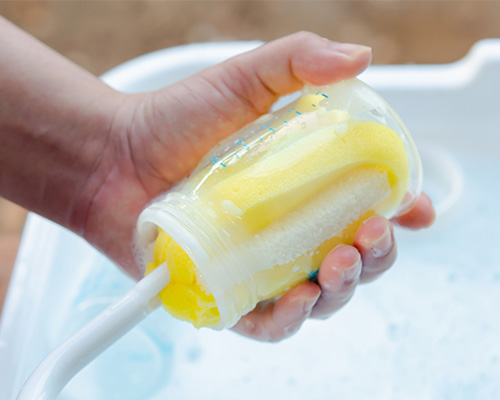
Sanitizing Bottles
Daily sanitization is particularly important if your baby is younger than 2 months, was born prematurely or has a weakened immune system. Daily sanitizing of feeding items may not be necessary for older, healthy babies if those items are cleaned carefully after each use.
Bottle parts and nipples can be sanitized in the dishwasher using hot water and a heated drying cycle (or sanitizing setting) using the same instructions as above, or on a stove.
To sanitize on the stove
- Place the bottle parts and nipples in a large pot, cover with water and boil for five minutes.
- Carefully remove items from the pot and place them upside-down on a clean cloth or paper towel to air dry.
- If you are not using the air-dried parts right away, put them back together and store them in a protected area, such as inside a closed kitchen cabinet with clean dishes.
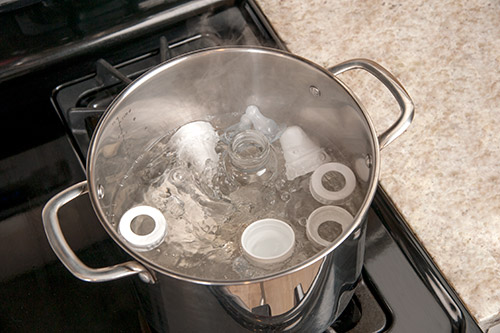
Making the Formula
1. Start with a clean surface. Wipe down the area where you will prepare the bottles.
2. Wash your hands for 20 seconds with soap and warm water.
3. Read the instructions on the formula label to find out how much water and formula you should mix. Adding more or less formula than instructed can affect how your baby grows.
4. Make sure you’re using water from a safe source. If you aren’t sure if your water is safe, check with your local health department or your WIC office.
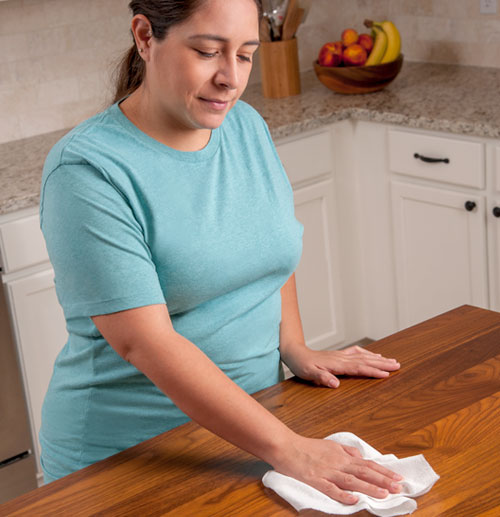
Protect Against Bacteria
Because powdered formula is not sterile, some babies need a little extra protection. If your baby is younger than 2 months of age, was born prematurely or has a weakened immune system, the following steps are recommended to protect against bacteria that may be in the formula.
Powdered formula:
- Powdered formula is not sterile, so you need very hot water to kill bacteria. Heat the water to at least 158 F/70 C. To do this, boil the water and then let it cool for five minutes.
- Pour the hot water into a clean and sanitized bottle, being careful to avoid burns. Add the correct amount of formula right away, attach the nipple, ring and cap to the bottle, then shake well to mix.
- Cool the formula to body temperature by holding the bottle under cold running water or placing it in a bowl of cold water. This will bring it to a safe temperature for your baby. Be sure to test the temperature of the formula on your wrist before feeding your baby the bottle.
Liquid concentrate formula:
Liquid concentrate formula is sterile, so the water you use does not need to be heated. Using water from a safe source, follow the mixing instructions on the can. Attach the nipple, ring and cap to the bottle, then shake well to mix.
To warm a cold bottle of formula, place it in warm water for several minutes. Never microwave formula, as it will heat unevenly and create hotspots that could burn your baby.
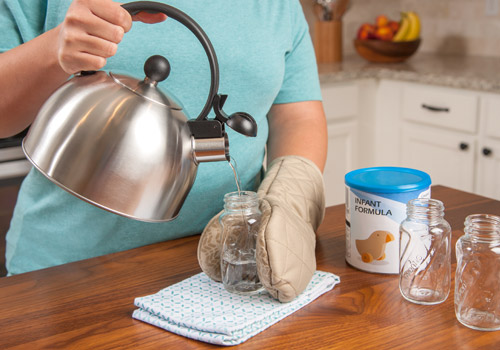
Feeding Your Baby
As a parent, you probably know how your baby likes to be held during feedings. Here are a few tips to keep things going smoothly:
1. Sprinkle a few drops of formula on your wrist to make sure that it is not too hot.
2. Start all feedings by following your baby’s signs that he is ready to eat. Look for hunger cues like your baby sucking on his fingers or turning to look for food with an open mouth.
3. Hold your baby so that his head is a little higher than the rest of his body. This can help prevent choking and ear infections and gives him more control over how much he eats. Eating too much can lead to an upset tummy and excess spit up.
4. Hold the bottle as level as possible, which slows down the flow of the milk. It’s OK if a little air is in the nipple. After about 10 seconds, give him a break by lowering the bottle’s nipple. When he’s done, he may be awake and quiet with his hands open and relaxed, or even fall asleep.
Never prop your baby’s bottle up with a pillow or blanket or leave your baby unattended while he’s eating.
5. Throw out any formula left in the bottle after one hour. The combination of infant formula and your baby’s saliva can cause germs to grow.
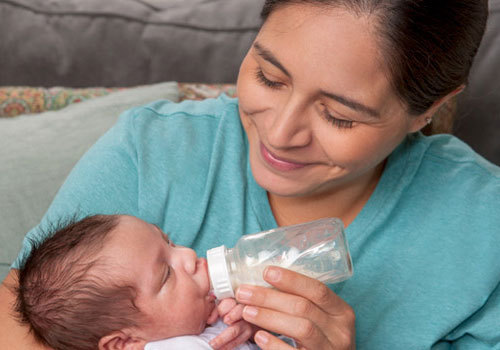
Storing Formula
It’s important to store formula containers in a cool, dry, indoor place — not in cars, garages or outdoors.
- Keep powdered formula lids and scoops on clean surfaces.
- Close containers of powdered infant formula as soon as possible.
- Use prepared formula within two hours of mixing it and within one hour from the beginning of a feeding. If you’re not using the prepared formula right away, put it in the refrigerator and use it within 24 hours.
- When in doubt, throw it out. If you can’t remember when you made the formula or you think it might be more than one hour old, it is safer to throw it out than to feed it to your baby.
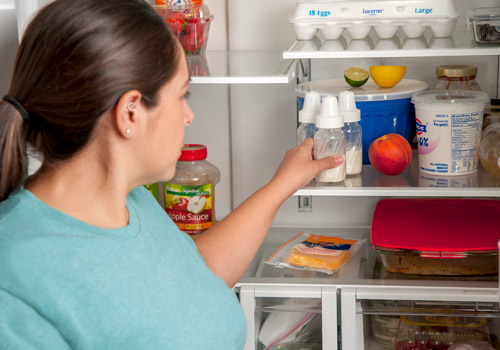

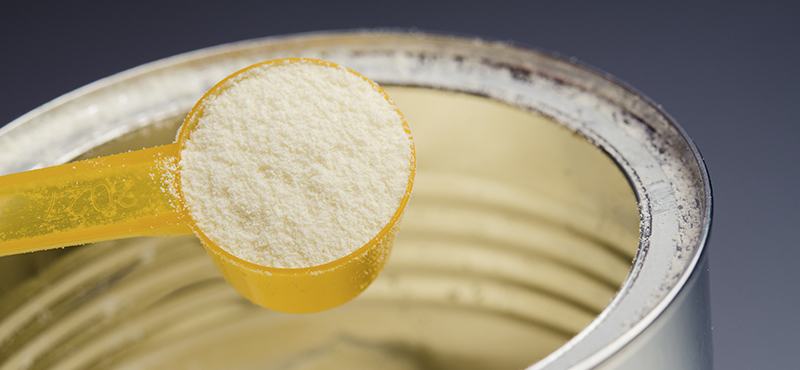

 Have any questions?
Have any questions?
